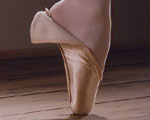Betsy Cullum-Swan & Peter
K. Manning
What is
a T-shiry? Codes, Chronotypes, and Everyday Objects.

In this article, Cullum-Swan and Manning set out a semiotic exploration of an article of clothing. While not entirely applicable (due to the fact that pointe shoes inhabit a place within ‘costume’ as opposed to ‘clothing’), three of the five paradigms they outline are useful tools in charting the shifting meaning or messages that are conveyed by an object (in this case, shoes): Function or Purposes, Primary Setting(s) for Use, Involvement of the Self.
Function or Purposes
Utilitarian function
The practical purpose of pointe shoes is to assist a dancer in rising
to the tips of her toes while performing techniques.
Expressive function
Dancing en pointe gives the impression of weightlessness or floating.
Why this effect should be coveted and honoured in terms of ballet is a
question I shall like to pursue. The ethereal quality of techniques performed
en pointe seems to undermine the athleticism of dance. Why is the power
of the dancer effaced in this way?
Purposes (social values)
This is less explicit but gives rise to certain questions. Is there a
“personality type’ associated with the image of a dancer en
pointe (ex. tempermental, anorexic, etc.)? Has this “type”
shifted over time, since point shoes came into use? Have pointe shoes
become affiliated with these types or characteristics after the fact or
do they somehow confirm and underscore these conventions?
Primary Setting(s) for Use
Stage
The stage is the public face of ballet and pointe shoes reflect this
aspect. Performance requires shoes that look untouched to the audience.
The idea of effortlessness is enforced by the newness of the shoes:
the dancer seems to be naturally skilled, no sign of practice or hard
work displayed. This is somewaht paradoxical due to the fact that it
is on stage that a dancer most requires her well-broken in, well-formed
shoes.
Dance studio
This space represents the semi-private area where the dancer is able
to hone her skills and practice. Here the shoes tell more of a story.
They are usually fraying at the toes, have broken shanks and are scuffed
along the base of the shoe.
Involvement of the Self (the self and representational themes)
There is little outward individual expression in pointe shoes since they
show little variation from dancer to dancer to outside eyes.
Inward/hidden individual expression
For each individual dancer, shoes become part of or an extension of
the foot. This is personalized for each dancer since every foot is different.
Right foot can never be exchanged for left nor can a pair be borrowed
without feeling the trade for the worse. A personalized, well-broken
in pair of shoes will help balance, stability, and technique. Do these
inward forms of expression hold any significance for dancers? Is there
a sense of pride in the uniqueness of each shoe, even if it isn't outwardly
apparent?